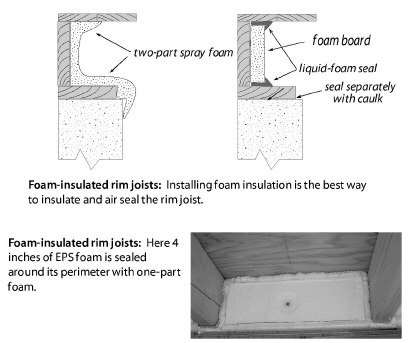
6.3 Preparing for Foundation or Floor Insulation
|
SWS Detail: 4.1402.2 Basement Wall Insulation—No Groundwater Leakage, 4.1402.3 Basement Wall Insulation—Groundwater Leakage |
Floor and foundation insulation can increase the likelihood of moisture problems. Installers should take all necessary steps to prevent moisture problems from ground moisture before installing insulation.
6.3.1 Rim-Joist Insulation and Air-Sealing
|
SWS Detal: 4.1401.1 Band/Rim Joists—Spray Polyurethane Foam (SPF) Installation |
The rim-joist spaces at the perimeter of the floor are a major weak point in the air barrier and insulation. Insulating and air sealing both the rim joist and longitudinal box joist are appropriate either as individual procedures or as part of floor or foundation insulation.
Air seal stud cavities in balloon-framed homes as a part of insulating the rim joist. Air seal other penetrations through the rim before insulating. Two-part spray foam is the most versatile air sealing and insulation system for the rim joist because spray foam air seals and insulates in one step. If you leave the spray foam exposed, it should have a flame spread of 25 or less and be no more than 3.25 inches thick according to the IRC.
Polystyrene or polyurethane rigid board insulation are also good for insulating and air sealing the rim joist area. When the rim joist runs parallel to the foundation wall, the cavity may be air sealed and insulated with methods similar to those as shown here.

Don’t use fiberglass batts to insulate between rim joists because air can move around the fiberglass, causing condensation and encouraging mold on the cold rim joist. If you use foam to insulate between the rim joists, use liquid foam sealant to seal around the edges of the rigid foam.
6.3.2 Installing Floor Insulation
The best way to insulate a floor cavity is to completely fill each joist cavity with fiberglass insulation. Blowing fiberglass insulation is the easiest way to achieve complete coverage because the blown fiberglass is able to surround obstructions and penetrations better than fiberglass batts. Avoid blown cellulose because of its weight, moisture absorption, and tendency to settle.
Before installing fiberglass floor insulation, make the following preparations.
ü Seal air leaks in the floor from the living space or the crawl space or basement as opportunity allows.
ü Seal and insulate ducts remaining in the crawl space or unconditioned basement.
ü Identify electrical junction boxes, plumbing valves and drains before insulating and provide access to them.
ü Insulate water lines in cold climates if they protrude below the insulation.
Many installers prefer to blow fiberglass insulation into the floor, rather than installing batts, to insulate more easily and effectively around obstacles. Cellulose is not recommended for blowing floors because of concerns about settling and moisture. Observe these specifications for blown-in floor insulation.
ü Cover the entire under-floor surface with a vapor permeable supporting material such as: dust-free fabric insulation restraint or equivalent vapor-permeable and drain-able material.
ü Use wood strips to support the flexible or semi-flexible support material unless that material with its fasteners can support the floor insulation without sagging.

ü Install rock wool or fiberglass blowing wool through V-shaped holes in the air barrier.
ü Use a fill tube for installing the blown insulation. Insulation must travel no more than 12 inches from the end of the fill tube.
ü Seal all penetrations in the air barrier with a tape, approved for sealing seams in the air-barrier material.
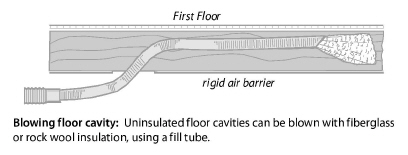
6.3.3 Installing Fiberglass Batt Floor Insulation
|
SWS Detail: 4.1301.1 Standard Floor System—Batt Installation, 4.1301.5 Cantilevered Floor—Batt Installation, 4.1301.6 Pier Construction Subfloor Insulation—Batt Installation with Rigid Barrier |
Observe these material specifications for insulating under floors.
ü Seal all significant air leaks through the floor before insulating the floor, using strong airtight materials.
ü Choose unfaced batts for insulating floors.
ü Install batts in continuous contact with the subfloor.
ü Batt thickness must fill the complete depth of each cavity.
ü Batts must be neatly installed, fitting tightly together at joints, fitting closely around obstructions, and filling all the space within the floor cavity.
ü Crawl-space access doors, adjacent to a conditioned space, must be insulated to at least R-21 for horizontal openings and to at least R-15 for vertical openings.
ü Crawl-space access doors must be effectively weatherstripped.
Installation Specifications for Batts in Floor Cavities
Batt insulation, installed in floors, must be supported by twine, wire, wood lath or other suitable material that keeps the insulation touching the floor. Friction-fit fiberglass batts supported by self-supporting wire insulation supports aren’t good practice. Fasteners for floor insulation must resist gravity, the weight of insulation, and moisture condensation.
Use one of the following restrainer materials to keep the fiberglass batts in the floor cavity.
• Install standard wood lath (1/4 inch by 1 inch) or nominal one-inch lumber. Install the lath or lumber perpendicular to joists 12 inches apart for joists on 24-inch centers and 18 inches apart for joists on 16-inch centers.
• Install non-stretching polypropylene or polyester twine.
• Install copper or stainless steel wire with a minimum diameter of 0.04 inches or size 18 AWG.
• Install a rigid vapor-permeable air barrier, such as plywood.
Observe these requirements about installation and fasteners for the restrainers.
• Fasten lath or a rigid barrier with screws, nails, or power-driven staples. The fastener should penetrate the joist 3/4 inch or more.
• Install twine or wire in a zig-zag pattern.
• Install power-driven staples over the twine or wire 12 inches apart for joists on 24-inch centers and 18 inches apart for joists on 16-inch centers. The staples must penetrate the wood joists by at least 5/8 inch. Don’t hand staple the restrainer.
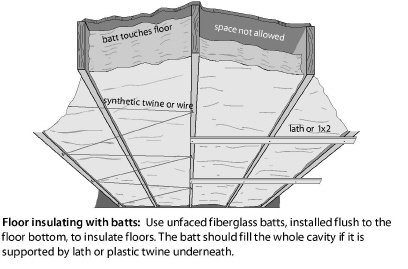
6.3.4 Crawl-Space Wall Insulation
|
SWS Detail: 4.1401.1 Band/Rim Joists—Spray Polyurethane Foam (SPF) Installation |
Crawl-space foundation insulation is only worthwhile if you can seal the existing foundation vents. See "Power-Ventilated Crawl Spaces" on page 368.
Materials for Crawl-Space Insulation
Retrofit foundation insulation is usually installed on the inside of the foundation walls. Exterior insulation is common in new construction because it is more effective than interior insulation at keeping the foundation warm and dry.
• Fiberglass blankets can be a good insulation choice for very dry crawl spaces. However, the fiberglass facing is a vapor barrier like vinyl or foil facing can trap moisture in the insulation.
• Extruded or expanded polystyrene insulations are the best insulation products for the interior of flat concrete or concrete-block walls. Foam sheets are good air barriers and have excellent moisture resistance.
• For rubble masonry walls, use two-part spray foam.
Consider the following issues when insulating foundation walls.
ü If an open-combustion appliance is located in crawl space, take precautions to assure that outdoor combustion air is available to the appliance.
ü When insulating a crawl-space walls, consult the local building inspector about ventilation options.
ü Outside access hatches should be securely attached to foundation walls. If the foundation walls are insulated, also insulate any crawl-space access hatch with foam to the R-value of the foundation wall. Use treated wood for access doors that contact the ground.
ü In regions affected by termites, carpenter ants, and similar insects, consult with experts to ensure that the insulation, air sealing materials, and moisture barrier don’t provide a conduit for insects to infest the wood floor.
Insulating the foundation walls instead of the floor usually leaves a large uninsulated area of the home’s thermal boundary — the ground in the crawl space.
Crawl-Space-Wall Insulation Materials Compared
Crawl-space foundation insulation is rather complex from the perspective of materials. Foam insulation has special fire considerations. Faced fiberglass can trap moisture. Sprayed fiberglass can be damaged by moisture and mechanical abrasion. Any of the options can harbor termites. Consider the following suggestions about crawl-space foundation insulation materials.
.
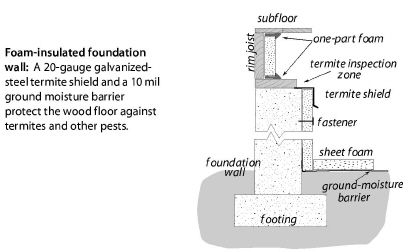
Attach insulation firmly to the foundation wall’s surface with masonry fasteners and/or adhesive. Install insulation with no significant voids or edge gaps.
• Sprayed closed-cell polyurethane foam is available in at least two varieties according to flame spread: 25 and 75. Use the flame-spread-25 variety of foam if you want to avoid using an ignition barrier.
• Some building inspectors allow plastic foam insulation to be installed uncovered in crawl spaces, and some building inspectors require it to be covered by a ignition barrier.
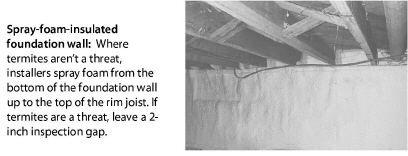
• When an ignition barrier is required, foam insulation must be protected by 11/2 inch thick of fiberglass insulation or a sprayed latex ignition barrier.
• FSK (foil-scrim-kraft) or vinyl-faced fiberglass insulation is often used to insulate foundation walls on the interior surface. Both of these facings are vapor barriers and can trap moisture inside the insulation.
• Cover basement foundation insulation with a material that has an ASTM flame spread rating of 25 or less, such as half-inch drywall. FSK fiberglass usually requires no ignition barrier.
|
SWS Detail: 4.1402.2 Basement Wall Insulation—No Groundwater Leakage, 4.1402.3 Basement Wall Insulation—Groundwater Leakage |
Basement wall is often installed poorly because of the installers’ incomplete understanding about moisture problems.
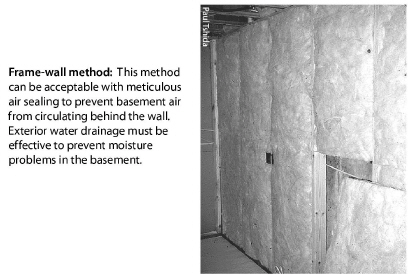
The most common (although not the best) way to insulate basement walls, or any masonry wall, is to build a framed wall against the masonry wall and fill the wall with fiberglass batts. The frame wall is then covered with drywall.
Unfaced batts are the best choice of fiberglass insulation since they contain no vapor barrier to trap moisture. Moisture may escape from the wall in either direction: from outdoors in or indoors out.
With a framed wall, the installer often neglects to seal in areas where the wall is discontinuous, such as a mechanical room. Any area, such as an unfinished wall, open rim-joist area, or un-sheeted ceiling, constitutes a very large air leak around the insulated wall. Avoid this problem by doing these procedures.
ü Insulate the rim joist and air seal it.
ü Build the frame walls.
ü Wall off the entire basement. If a mechanical room or other area will not be insulated, install an airtight block at the wall’s edge to prevent basement air from circulating behind the insulated wall.
ü Don’t install a vapor barrier on the interior face of the new basement wall. The wall must be able to dry toward indoors or to the outdoors.
ü Install drywall in an airtight manner on the walls and ceiling by applying sealant to the back or each sheet around its perimeter.
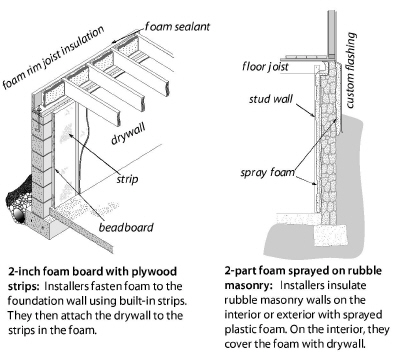
Exterior Foam Foundation Insulation
If installed at the exterior, as during new construction, use durable water-resistant insulation such as blue or pink extruded polystyrene or high-density (2 pcf) expanded polystyrene. For portions that are exposed above ground level and six inches below ground, you’ll need to provide mechanical and moisture protection such as sheet metal or fiberglass panels. For areas more than 6 inches below grade, there are asphalt-based sealants for the foam that are applied with a paint roller.